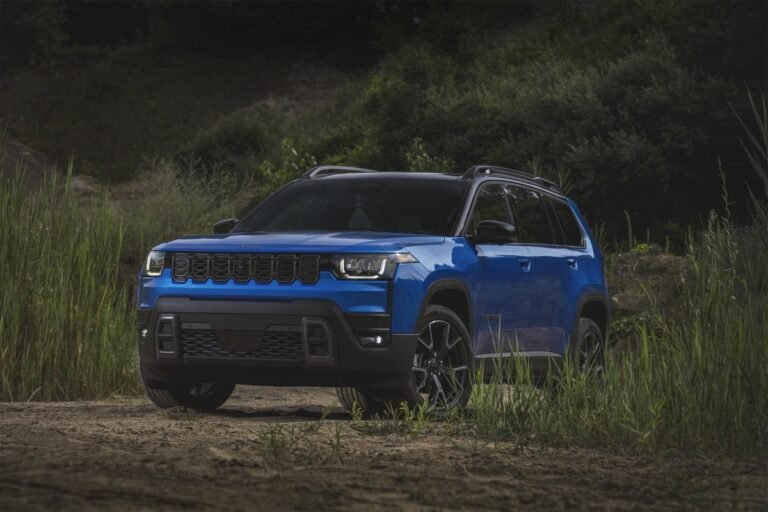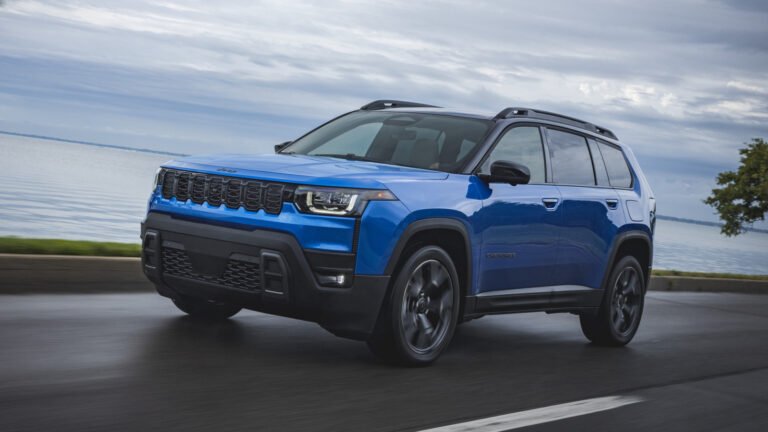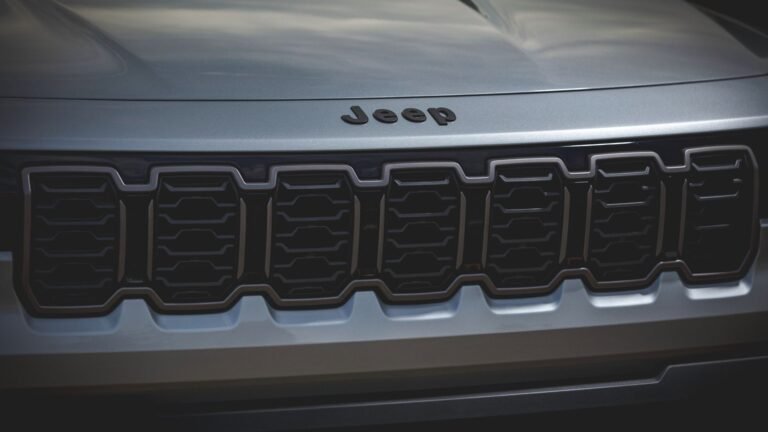

- Jeep has introduced the 2026 Cherokee, ahead of its launch later this year.
- The redesigned crossover sports an all-new hybrid powertrain with 210 hp.
- It is significantly larger than its predecessor and returns 37 mpg combined.
The Jeep Cherokee is back, larger and more refined than before, with an added touch of efficiency thanks to its new hybrid powertrain that returns 37 mpg combined. The redesign aims to balance rugged appeal with a more upscale feel, moving the nameplate into the competitive hybrid crossover segment.
Since we’ve already seen the exterior, we’ll briefly note it features a “super vertical” front end with a slender grille and rectangular headlights that loosely recall the Cherokee XJ. They’re joined by angular bodywork and heavy cladding.
Michael Gauthier / Carscoops
Designers also gave the model an expansive greenhouse and flush-mounted door handles. They’re joined by 17- to 20-inch wheels, which are wrapped in either Nexen Roadian GTX or Pirelli Scorpion MS all-season tires.
Out back, there’s a heavily stylized liftgate with a subtle nod to the XJ in the form of familiar cut lines. They’re easy to over look as eyes are naturally drawn to the contrasting black license plate recess and taillights that draw inspiration from jerry cans.
In terms of size, the Cherokee measures 188.1 inches (4,778 mm) long, 83.6 inches (2,123 mm) wide, and 67.5 inches (1,715 mm) tall with a wheelbase that spans 113 inches (2,870 mm). That means the redesigned model is 4.7 inches (119 mm) longer, 1 inch (25 mm) wider, and 2 inches (50 mm) taller. There’s an additional 6.4 inches (163 mm) between the wheels and this results in a far more spacious cabin.
A Classy And Comfortable Cabin
Michael Gauthier / Carscoops
While the exterior is sharp and edgy, the luxurious cabin follows in the footsteps of the Wagoneer S. Drivers sit behind a squared off steering wheel and find themselves looking at a 10.25-inch digital instrument cluster. It’s joined by a 12.3-inch Uconnect 5 infotainment system with wireless Android Auto and Apple CarPlay.
Speaking of technology, every Cherokee will come with a ten year subscription to Connect One. It allows for over-the-air updates, automatic emergency calls, and connectivity with the Jeep smartphone app.
Getting back to the interior, it’s open, airy, and minimalist. Part of this is due to the revamped center console, which features a rotary gear selector as well as a small Selec-Terrain switch with Auto, Sport, Snow, and Sand/Mud settings.
The Cherokee KL’s numerous buttons and knobs have been jettisoned as the latest model relies heavily on the infotainment system. That being said, there are dedicated climate controls as well as a handful of buttons for vehicle features. Even the door handles have been eliminated as they’ve been replaced by ‘digital latches.’
Despite being more luxurious, the Cherokee eschews leather as part of an eco-friendly push that sees the premium material replaced by Capri vinyl. It seems nice enough and features a unique perforation pattern on the Overland trim, but nothing beats the real deal.
On the topic of going green, the crossover uses an assortment of recycled materials. These have been used to help create the headliner, carpeting, and some soft trim components.
Despite being significantly larger than its predecessor, second-row legroom falls from 40.3 inches (1,023 mm) to 38.5 inches (977 mm). That’s a significant drop, but this 6’ 2” scribe was perfectly comfortable in back and there’s a surprising amount of headroom to boot. Jeep officials also pointed out rear seat passengers will find an additional 2.5 inches (64 mm) of shoulder room as well as an extra 5.2 inches (132 mm) of hip room.
While second-row legroom shrinks, cargo capacity grows by 30%. Jeep said customers wanted more space, so they delivered 33.6 cubic feet (952 liters) behind the second-row and 68.3 cubic feet (1,934 liters) behind the front seats. That’s up from 54.7 cubic feet (1,549 liters) in the old model.
Jeep was coy on equipment details, but mentioned a number of options including heated and ventilated front seats as well as heated rear seats. Customers will also be able to get a digital rearview mirror, a dual-pane sunroof, an Alpine audio system, and a foot-activated power liftgate.
A Hybrid Heart
Power comes from a turbocharged 1.6-liter four-cylinder engine that produces 177 hp (132 kW / 179 PS) and 221 lb-ft (300 Nm) of torque. It’s paired to a hybrid system, which features two electric motors, an electronically controlled continuously variable transmission, and a 1.08 kWh lithium-ion battery pack.
This setup gives the crossover a combined output of 210 hp (157 kW / 213 PS) and 230 lb-ft (312 Nm) of torque. That’s significantly more than the old 2.4-liter four-cylinder and Stellantis’ head of global propulsion systems, Micky Bly, told us the “torque comes on early and stays strong.” He also noted the powertrain has been subjected to “thousands of miles of development and testing.”
The hybrid powertrain is paired to a standard four-wheel drive system with a rear-axle disconnect to maximize efficiency. This enables the crossover to return 42 mpg city, 33 mpg highway, and 37 mpg combined.

Michael Gauthier / Carscoops
Jeep is excited about offering their first hybrid in America, but the Cherokee trails a number of key rivals. The 2026 Toyota RAV4 produces up to 236 hp (176 kW / 239 PS), while the Hyundai Tucson Hybrid has 231 hp (172 kW / 234 PS). The latter model also offers up to 38 mpg combined.
The Cherokee rides on the STLA Large platform and has a towing capacity of 3,500 lbs (1,587 kg). That’s less than the KL and the model is also heavier as the curb weight climbs from 3,875 lbs (1,758 kg) to 4,295 lbs (1,948 kg).
Those looking to venture off-road will find approach, departure, and breakover angles of 19.6°, 29.4°, and 18.8°. Jeep noted the approach and departure angles are best-in-class, and they’re accompanied by 8 inches (203 mm) of ground clearance. This should provide a decent amount of capability, but serious off-roaders will want to wait for the upcoming Trailhawk.
An assortment of driver assistance systems come standard including active driving assist, which combines adaptive cruise control with a lane centering function. Customers will also find intersection collision assist, rear park assist with automatic emergency braking, and blind-spot monitoring with rear cross path detection. There’s also forward automatic emergency braking with pedestrian and cyclist detection. Buyers can also get an optional 360° camera system as well as a system that shows your blind spots when a turn signal is activated.
Starts At $36,995
There’s a lot to like about the 2026 Cherokee, but pricing starts at $36,995 including a $1,995 destination fee. That’s $2,035 more than the Tucson Hybrid and $5,260 more than the Kia Sportage Hybrid. It will also likely be more expensive than the 2026 RAV4 as the outgoing hybrid starts at $34,050.
Deliveries are slated to begin late this year and the initial focus will be on the Limited and Overland trims. The cheaper Cherokee and Laredo variants will follow in early 2026, and all will be imported from Toluca, Mexico.
2026 Jeep Cherokee Pricing
SWIPE
Prices include a $1,995 destination fee






